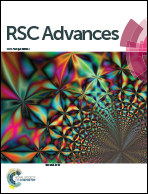Microheterogeneity in binary mixtures of methanol with aliphatic alcohols: ATR-IR/NIR spectroscopic, chemometrics and DFT studies
Abstract
This paper reports ATR-IR and NIR spectroscopic studies on microheterogeneity in binary mixtures of methanol with five short chain aliphatic alcohols: ethanol, 1-propanol, 2-propanol, tert-butanol and cyclopentanol. The inhomogeneity distribution of molecules in the mixtures was characterized by MIR/NIR excess absorption spectra, two-dimensional correlation approach, and chemometric methods. The experimental data were compared and discussed with the theoretical calculations of homo- and heteroclusters of different size and composition. The results obtained in the present work allow us to infer that all studied mixtures deviate from the ideal and the largest effect appears at equimolar mixture. At this composition about 50% of molecules are involved in the mixed clusters. In the entire range of compositions in the mixtures coexist the clusters of pure alcohols and heteroclusters with an average mole ratio of 1 : 1. Only in methanol/tert-butanol mixture was observed an additional tert-butanol-rich cluster with an average methanol : tert-butanol mole ratio between 1 : 3 and 1 : 4. The excess absorption and two-dimensional correlation spectra reveals that methanol/ethanol mixture is the closest to the ideal one, while the largest degree of non-ideality was observed for methanol/tert-butanol mixture. The extent of deviation from the ideal mixture increases with an increase in the chain length and the order of the alcohol. These trends are correlated with decreasing degree of self-association of the alcohol.


 Please wait while we load your content...
Please wait while we load your content...